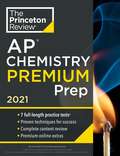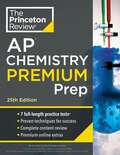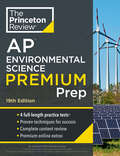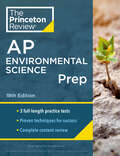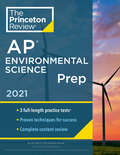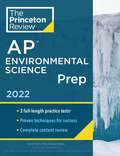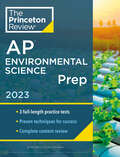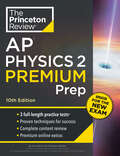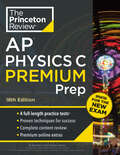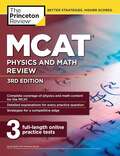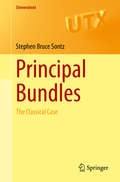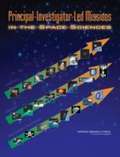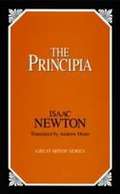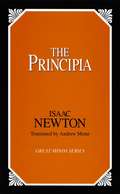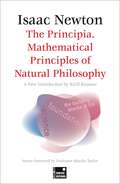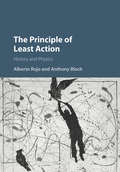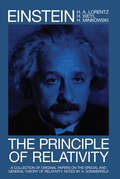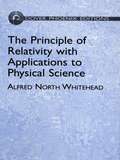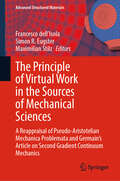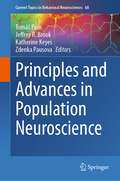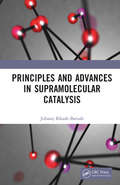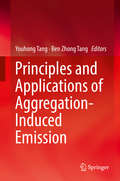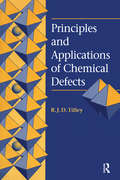- Table View
- List View
Princeton Review AP Chemistry Premium Prep 2021 (College Test Preparation Series)
by The Princeton ReviewEquip yourself to ace the AP Chemistry Exam with this comprehensive study guide—including 7 full-length practice tests (the MOST full-length tests on the market!), thorough content reviews, targeted strategies for every section, and access to online extras.
Princeton Review Ap Chemistry Premium Prep, 25th Edition: 7 Practice Tests + Complete Content Review + Strategies And Techniques
by The Princeton The Princeton ReviewEVERYTHING YOU NEED TO HELP SCORE A PERFECT 5, WITH THE BEST PRACTICE ON THE MARKET! Equip yourself to ace the AP Chemistry Exam with this comprehensive study guide—including 7 full-length practice tests (the MOST full-length tests on the market!), thorough content reviews, targeted strategies for every section, and access to online extras. Techniques That Actually Work • Tried-and-true strategies to help you avoid traps and beat the test • Tips for pacing yourself and guessing logically • Essential tactics to help you work smarter, not harder Everything You Need for a High Score • Fully aligned with the latest College Board standards for AP Chemistry • Comprehensive content review for all test topics • Engaging activities to help you critically assess your progress • Access to study plans, a handy list of key equations, helpful pre-college information, and more via your online Student Tools Premium Practice for AP Excellence • 7 full-length practice tests (5 in the book, 2 online) with detailed answer explanations • Practice drills at the end of each content review chapter • Review of important laboratory procedures and equipment
Princeton Review AP Environmental Science Premium Prep, 19th Edition: 4 Practice Tests + Complete Content Review + Strategies & Techniques (College Test Preparation)
by The Princeton ReviewPREMIUM PRACTICE FOR A PERFECT 5! Ace the AP Environmental Science Exam with The Princeton Review's comprehensive study guide—including 4 full-length practice tests (3 in book; 1 online) with complete explanations, thorough content reviews, targeted strategies for every question type, and access to online extras.Techniques That Actually Work• Tried-and-true strategies to help you avoid traps and beat the test• Tips for pacing yourself and guessing logically• Essential tactics to help you work smarter, not harderEverything You Need for a High Score• Targeted review of commonly tested concepts for the AP® Environmental Science Exam• Detailed figures, graphs, and charts to illustrate important world environmental phenomena• Thorough lists of key terms for every content review chapter• Online digital flashcards to review core contentPremium Practice for AP Excellence• 4 full-length practice tests (3 in the book and 1 online) with detailed answer explanations and scoring worksheets• Practice drills at the end of each content review chapter• Quick-study glossary of the terms you should know
Princeton Review AP Environmental Science Prep, 18th Edition: 3 Practice Tests + Complete Content Review + Strategies & Techniques (College Test Preparation)
by The Princeton ReviewEVERYTHING YOU NEED TO HELP SCORE A PERFECT 5! Ace the AP Environmental Science Exam with this comprehensive study guide—including 3 full-length practice tests with complete explanations, thorough content reviews, targeted strategies for every question type, and access to online extras.Techniques That Actually Work• Tried-and-true strategies to help you avoid traps and beat the test• Tips for pacing yourself and guessing logically• Essential tactics to help you work smarter, not harderEverything You Need for a High Score• Fully aligned with the latest College Board standards for AP Environmental Science• Thorough content review on all nine units covered in the Course and Exam Description• Detailed figures, graphs, and charts to illustrate important world environmental phenomena• Access to study plans, helpful pre-college information, and more via your online Student ToolsPractice Your Way to Excellence• 3 full-length practice tests with detailed answer explanations and scoring worksheets• Practice drills at the end of each content review chapter• Quick-study glossary of the terms you should know
Princeton Review AP Environmental Science Prep, 2021: 3 Practice Tests + Complete Content Review + Strategies & Techniques (College Test Preparation)
by The Princeton ReviewEVERYTHING YOU NEED TO HELP SCORE A PERFECT 5, now with 33% more practice than previous editions!Ace the 2021 AP Environmental Science Exam with this comprehensive study guide—including 3 full-length practice tests with complete explanations, thorough content reviews, targeted strategies for every question type, and access to online extras. Techniques That Actually Work.• Tried-and-true strategies to help you avoid traps and beat the test• Tips for pacing yourself and guessing logically• Essential tactics to help you work smarter, not harderEverything You Need to Know to Help Achieve a High Score. • Detailed figures, graphs, and charts to illustrate important world environmental phenomena• Updated to align with the latest College Board standards• Thorough lists of key terms for every content chapter• Access to study plans, helpful pre-college information, and more via your online Student ToolsPractice Your Way to Excellence.• 3 full-length practice tests with detailed answer explanations and scoring worksheets• Practice drills at the end of each content review chapter• Quick-study glossary of the terms you should know
Princeton Review AP Environmental Science Prep, 2022: Practice Tests + Complete Content Review + Strategies & Techniques (College Test Preparation)
by The Princeton ReviewEVERYTHING YOU NEED TO HELP SCORE A PERFECT 5! Ace the 2022 AP Environmental Science Exam with this comprehensive study guide—including 3 full-length practice tests with complete explanations, thorough content reviews, targeted strategies for every question type, and access to online extras. Techniques That Actually Work.• Tried-and-true strategies to help you avoid traps and beat the test• Tips for pacing yourself and guessing logically• Essential tactics to help you work smarter, not harderEverything You Need to Know to Help Achieve a High Score. • Fully aligned with the latest College Board standards for AP Environmental Science• Thorough content review on all nine units covered in the Course and Exam Description• Detailed figures, graphs, and charts to illustrate important world environmental phenomena• Access to study plans, helpful pre-college information, and more via your online Student ToolsPractice Your Way to Excellence.• 3 full-length practice tests with detailed answer explanations and scoring worksheets• Practice drills at the end of each content review chapter• Quick-study glossary of the terms you should know
Princeton Review AP Environmental Science Prep, 2023: 3 Practice Tests + Complete Content Review + Strategies & Techniques (College Test Preparation)
by The Princeton ReviewEVERYTHING YOU NEED TO HELP SCORE A PERFECT 5! Ace the 2023 AP Environmental Science Exam with this comprehensive study guide—including 3 full-length practice tests with complete explanations, thorough content reviews, targeted strategies for every question type, and access to online extras. Techniques That Actually Work • Tried-and-true strategies to help you avoid traps and beat the test • Tips for pacing yourself and guessing logically • Essential tactics to help you work smarter, not harder Everything You Need for a High Score • Fully aligned with the latest College Board standards for AP Environmental Science • Thorough content review on all nine units covered in the Course and Exam Description • Detailed figures, graphs, and charts to illustrate important world environmental phenomena • Access to study plans, helpful pre-college information, and more via your online Student Tools Practice Your Way to Excellence • 3 full-length practice tests with detailed answer explanations and scoring worksheets • Practice drills at the end of each content review chapter • Quick-study glossary of the terms you should know
Princeton Review AP Physics 2 Premium Prep, 10th Edition: 3 Practice Tests + Digital Practice Online + Content Review (College Test Preparation)
by The Princeton ReviewEVERYTHING YOU NEED TO HELP SCORE A PERFECT 5! Ace the NEWLY-UPDATED AP Physics 2 Exam with this comprehensive study guide—including 3 full-length practice tests (2 in the book, 1 online) with complete explanations, content reviews, exam strategies, and access to online extras.AP Physics 2 is getting an update! Starting with the Fall 2024 course and the May 2025 exam, students testing on this challenging topic will find both an expanded range of content and a revised exam format with new question types. This book addresses it all and helps you approach test day with confidence.Techniques That Actually Work• Tried-and-true strategies to avoid traps and beat the test• Tips for pacing yourself and guessing logically• Essential tactics to help you work smarter, not harderEverything You Need for a High Score• Fully updated to reflect the latest College Board standards for AP® Physics 2• Comprehensive coverage of thermodynamics, electrostatics, magnetic fields, electromagnetism, geometric and physical optics, and more• Tons of charts and figures to illustrate key concepts• Access to study plans, a handy list of equations and formulas, helpful pre-college information, and more via your online Student ToolsPractice Your Way to Excellence• 3 full-length practice tests (2 in the book, 1 online) with detailed answer explanations• Practice drills at the end of each content review chapter• Step-by-step walk-throughs of sample questions
Princeton Review AP Physics C Premium Prep, 18th Edition: 4 Practice Tests + Digital Practice Online + Content Review (College Test Preparation)
by The Princeton ReviewEVERYTHING YOU NEED TO HELP SCORE A PERFECT 5! Ace the UPDATED AP Physics C Exam with this comprehensive study guide—including 4 full-length practice tests with complete answer explanations, content reviews, exam strategies, and bonus online extras.AP Physics C is getting an update! Starting with the Fall 2024 course and the May 2025 exam, students testing on this challenging topic will face a longer test with more questions, including four brand-new types of free response questions (FRQs). This book addresses it all and helps you approach test day with confidence.Techniques That Actually Work• Tried-and-true strategies to help you avoid traps and beat the test• Tips for pacing yourself and guessing logically• Essential tactics to help you work smarter, not harderEverything You Need for a High Score• Fully updated to reflect the latest College Board standards for AP® Physics C• Comprehensive content review for both Mechanics and Electricity & Magnetism• Tons of charts and figures to illustrate concepts• Access to study plans, a handy list of equations and formulas, helpful pre-college information, and more via your online Student ToolsPractice Your Way to Excellence• 4 full-length practice tests (2 in the book, 2 online) with detailed answer explanations• Practice drills at the end of each content review chapter• Step-by-step walk-throughs of sample Mechanics and Electricity & Magnetism exam questions
The Princeton Review® MCAT® Physics and Math Review (Graduate School Test Preparation)
by Princeton StaffInside this book, you'll find proven strategies for tackling and overcoming challenging questions, along with all the practice you need to help get the score you want. Everything You Need to Know to Help Achieve a High Score. * In-depth coverage of the challenging physics & math topics on this important test * Sample MCAT questions with step-by-step walk-through explanations * Bulleted chapter summaries for quick review * Full-color illustrations, diagrams, and tables * Extensive glossary for handy reference Practice Your Way to Excellence. * Access to 3 full-length practice tests online to help you gauge your progress * End-of-chapter drills and explanations * MCAT-style practice passages and questions * Test-taking strategies geared toward physics and math mastery Gain Mastery of These and Other Topics! * Kinematics * Mechanics * Fluids and Elasticity of Solids * Electrostatics * Electricity and Magnetism * Oscillations and Waves * Sound * Light and Geometrical Optics
Principal Bundles: The Classical Case (Universitext)
by Stephen Bruce SontzThis introductory graduate level text provides a relatively quick path to a special topic in classical differential geometry: principal bundles. While the topic of principal bundles in differential geometry has become classic, even standard, material in the modern graduate mathematics curriculum, the unique approach taken in this text presents the material in a way that is intuitive for both students of mathematics and of physics. The goal of this book is to present important, modern geometric ideas in a form readily accessible to students and researchers in both the physics and mathematics communities, providing each with an understanding and appreciation of the language and ideas of the other.
Principal-Investigator-Led Missions in the Space Sciences
by National Research Council of the National AcademiesPrincipal Investigator-Led (PI-led) missions are an important element of NASA’s space science enterprise. While several NRC studies have considered aspects of PI-led missions in the course of other studies for NASA, issues facing the PI-led missions in general have not been subject to much analysis in those studies. Nevertheless, these issues are raising increasingly important questions for NASA, and it requested the NRC to explore them as they currently affect PI-led missions. Among the issues NASA asked to have examined were those concerning cost and scheduling, the selection process, relationships among PI-led team members, and opportunities for knowledge transfer to new PIs. This report provides a discussion of the evolution and current status of the PIled mission concept, the ways in which certain practices have affected its performance, and the steps that can carry it successfully into the future. The study was done in collaboration with the National Academy of Public Administration.
The Principia
by Isaac Newton Andrew MotteSir Isaac Newton's Principia Mathematica (Mathematical Principles) (1687) is considered to be among the finest scientific works ever published. His grand unifying idea of gravitation, with effects extending throughout the solar system, explains by one principle such diverse phenomena as the tides, the precession of the equinoxes, and the irregularities of the moon's motion. Newton's brilliant and revolutionary contributions to science explained the workings of a large part of inanimate nature mathematically and suggested that the remainder might be understood in a similar fashion. By taking known facts, forming a theory that explained them in mathematical terms, deducing consequences from the theory, and comparing the results with observed and experimental facts, Newton united, for the first time, the explication of physical phenomena with the means of prediction. By beginning with the physical axioms of the laws of motion and gravitation, he converted physics from a mere science of explanation into a general mathematical system.
The Principia (Great Minds Series)
by Sir Isaac Newton translated by Andrew MotteSir Isaac Newton's Principia Mathematica (Mathematical Principles) (1687) is considered to be among the finest scientific works ever published. His grand unifying idea of gravitation, with effects extending throughout the solar system, explains by one principle such diverse phenomena as the tides, the precession of the equinoxes, and the irregularities of the moon's motion. Newton's brilliant and revolutionary contributions to science explained the workings of a large part of inanimate nature mathematically and suggested that the remainder might be understood in a similar fashion. By taking known facts, forming a theory that explained them in mathematical terms, deducing consequences from the theory, and comparing the results with observed and experimental facts, Newton united, for the first time, the explication of physical phenomena with the means of prediction. By beginning with the physical axioms of the laws of motion and gravitation, he converted physics from a mere science of explanation into a general mathematical system.
Principia Mathematica to *56
by Alfred North Whitehead Bertrand RussellThe great three-volume Principia Mathematica is deservedly the most famous work ever written on the foundations of mathematics. Its aim is to deduce all the fundamental propositions of logic and mathematics from a small number of logical premisses and primitive ideas, and so to prove that mathematics is a development of logic. This abridged text of Volume I contains the material that is most relevant to an introductory study of logic and the philosophy of mathematics (more advanced students will wish to refer to the complete edition). It contains the whole of the preliminary sections (which present the authors' justification of the philosophical standpoint adopted at the outset of their work); the whole of Part 1 (in which the logical properties of propositions, propositional functions, classes and relations are established); section 6 of Part 2 (dealing with unit classes and couples); and Appendices A and B (which give further developments of the argument on the theory of deduction and truth functions).
The Principia. Mathematical Principles of Natural Philosophy (Foundations)
by Sir Isaac Newton Professor Marika TaylorNewton's bold masterwork helped shaped the cultural landscape of the world today. Now in a digestible, pocket format for the modern reader.New concise edition with a new introduction, abridged for the modern reader. The Principia. Mathematical Principles of Natural Philosophy is one of the most important scientific works ever to have been written and has had a profound impact on modern science. Consisting of three separate books, the Principia states Newton&’s laws of motion and Newton&’s law of universal gravitation. Understanding and acceptance of these theories was not immediate, however by the end of the seventeenth century no one could deny that Newton had far exceeded all previous works and revolutionised scientific thinking.The FLAME TREE Foundations series features core publications which together have shaped the cultural landscape of the modern world, with cutting-edge research distilled into pocket guides designed to be both accessible and informative.
The Principle of Least Action: History And Physics
by Alberto Rojo Anthony BlochThe principle of least action originates in the idea that, if nature has a purpose, it should follow a minimum or critical path. This simple principle, and its variants and generalizations, applies to optics, mechanics, electromagnetism, relativity, and quantum mechanics, and provides an essential guide to understanding the beauty of physics. <P><P>This unique text provides an accessible introduction to the action principle across these various fields of physics, and examines its history and fundamental role in science. It includes - with varying levels of mathematical sophistication - explanations from historical sources, discussion of classic papers, and original worked examples. The result is a story that is understandable to those with a modest mathematical background, as well as to researchers and students in physics and the history of physics.<P> Drawing from the original sources, this book discusses many of the key ideas in this area from both the scientific and historical perspectives to paint a broad picture of this unifying principle.<P> Discusses classic papers in a way that is accessible to the modern reader and will appeal to those who are interested in how physical concepts are generated.<P> Includes worked examples to show how the principle works in practice.
The Principle of Relativity
by Albert Einstein Francis A. DavisThis collection of original papers on the special and general theories of relativity is an unabridged translation of the 4th edition of Das Relativitatsprinzip, together with a revised edition of an additional paper by H. A. Lorentz.CONTENTS: I. "Michelson's Interference Experiment" by H. A . Lorentz. II. "Electromagnetic Phenomena in a System Moving with any Velocity Less than that of Light" by H. A . Lorentz. Ill. "On the Electrodynamics of Moving Bodies" by A. Einstein. IV. "Does the Inertia of a Body Depend Upon its Energy-Content?" by A. Einstein. V. "Space and Time" by H. Minkowski. VI. "On the Influence of Gravitation on the Propagation of Light" by A. Einstein. VII. "The Foundation of the General Theory of Relativity" by A. Einstein. VIII. "Hamilton's Principle and the General Theory of Relativity" by A. Einstein. IX. "Cosmological Considerations on the General Theory of Relativity" by A. Einstein. X. "Do Gravitational Fields Play an Essential Part in the Structure of the Elementary Particles of Matter?" by A. Einstein. XI. "Gravitation and Electricity" by H. Weyl."The book constitutes an indispensable part of a library on relativity," Nature. "It is really a thrill to read again the original papers by these giants," School Science and Mathematics. "Warmly recommended," Quarterly of Applied Mathematics.
The Principle of Relativity with Applications to Physical Science
by Alfred North WhiteheadAn alternative rendering of the theory of relativity by a distinguished English mathematician and philosopher. Three-part treatment presents an overview of general principles, mainly philosophical in character; describes physical applications and the results deducible from the formulas assumed for the gravitation and electromagnetic fields; presents an exposition of the elementary theory of tensors.
The Principle of the Common Cause
by Gábor Hofer-Szabó Miklós Rédei László E. SzabóThe common cause principle says that every correlation is either due to a direct causal effect linking the correlated entities or is brought about by a third factor, a so-called common cause. The principle is of central importance in the philosophy of science, especially in causal explanation, causal modeling and in the foundations of quantum physics. Written for philosophers of science, physicists and statisticians, this book contributes to the debate over the validity of the common cause principle, by proving results that bring to the surface the nature of explanation by common causes. It provides a technical and mathematically rigorous examination of the notion of common cause, providing an analysis not only in terms of classical probability measure spaces, which is typical in the available literature, but in quantum probability theory as well. The authors provide numerous open problems to further the debate and encourage future research in this field.
The Principle of Virtual Work in the Sources of Mechanical Sciences: A Reappraisal of Pseudo-Aristotelian Mechanica Problemata and Germain’s Article on Second Gradient Continuum Mechanics (Advanced Structured Materials #224)
by Francesco Dell’Isola Simon R. Eugster Maximilian StilzThis book presents critical evaluations of various historical sources and their impact on technological development. The problem of the origins of the Principle of Virtual Work is discussed and an exegesis of the Pseudo-Aristotle Mechanica Problemata is presented. Readers will also find an exploration of the criteria used to evaluate scientific works, providing insight into the selection and preservation of significant scholarly contributions. In particular, the case of Continuum Mechanics textbooks selection in XX century is examined.
Principles and Advances in Population Neuroscience (Current Topics in Behavioral Neurosciences #68)
by Tomáš Paus Jeffrey R. Brook Katherine Keyes Zdenka PausovaPopulation Neuroscience is aimed at enhancing our understanding of forces that shape the human brain and, as such, contribute to inter-individual variations in cognitive abilities, behavior and mental health throughout the lifespan. This book builds on a monograph Population Neuroscience (published by Springer in 2013; ISBN: 978-3-642-36450-1), a recent book on “Digital Ethology: Human Behavior in Geospatial Context” (published by MIT Press in 2024; ISBN: 9780262548137), and the collaborative work carried in the CHARGE and ENIGMA Consortia. Using collective expertise and knowledge with combining epidemiology, genetics and neuroimaging, the authors provide an overview of the basic principles and current advances in this field.
Principles and Advances in Supramolecular Catalysis
by Jubaraj Bikash BaruahSupramolecular catalysis is involved in assimilation or growth of biological products and it has advantages over conventional catalysis in dealing with systems beyond molecules to mimic the biological catalytic processes. Principles and Advances in Supramolecular Catalysis shows how a supramolecular catalytic reaction proceeds and how interactions among molecules provide vessels or specific binding sites to carry out chemical reactions. The utilities of such catalytic reactions in waste, hazard management, medicine, food, etc. are explained in this book. The book focuses on examples to provide a fundamental basis so that, in the future, supramolecular catalytic reactions are utilised in the field of chemical, biological, biophysical sciences and technologies. Features: Discusses fundamental and interdisciplinary aspects of supramolecular catalysis Narrates mechano-chemical and stimuli-guided supramolecular catalytic reactions Divulges the intriguing aspects of self-replications and self-assembling performed through supramolecular catalysis Incorporates supramolecular catalytic reactions of metal-organic frameworks as artificial metalloenzymes
Principles and Applications of Aggregation-Induced Emission
by Ben Zhong Tang Youhong TangThis book explores the aggregation-induced emission (AIE) effect, which has opened new avenues for the development of advanced luminogenic materials in the aggregate or solid state. By enabling light emission in the practically useful solid state, AIE has the potential to significantly expand the technological applications of luminescent materials. This book addresses principles, methods, and applications of AIEs, offering a new platform for the investigation of light-emitting processes from luminogen aggregates. Applications of AIE include biomedical diagnostics, sensor materials, and optoelectronic devices, among others, and are described in detail within the book. The development of a new generation of AIEgens, a deep understanding of the AIE mechanism(s), and the exploration of advanced technological applications will enable this exciting field to develop further. Headed by the pioneering researcher who started the field, Professor Ben Zhong Tang, this book combines both principles and applications and brings together global researchers in the field to report the progress, current challenges, and potential breakthroughs that may be accomplished in the near future. Provides an authoritative account of the fundamentals, properties, and potential of AIE by the pioneer of this active, highly-researched field;Highlights technological applications of AIE spanning biomedicine, sensor materials, and optoelectronics, among others;Presents a comprehensive view on challenges in the further development of AIE and derived technologies.
Principles and Applications of Chemical Defects
by Richard J.D. TilleyThis book provides some insight into chemical defects in crystalline solids, focusing on the relationship between basic principles and device applications. It is concerned with the chemical, optical and electronic consequences of the presence of defects in crystals.
